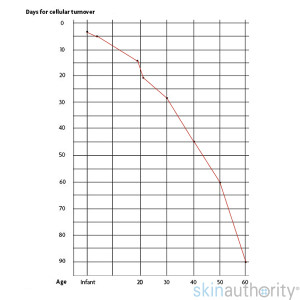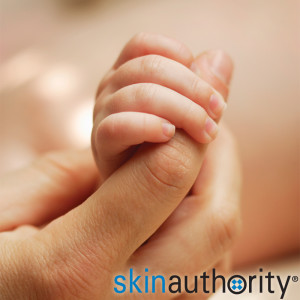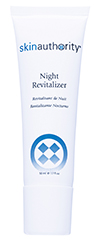- Part 1: The Basics
- Part 2: Cleansing Like A Pro
- Part 3: Resurfacing Transformation
In parts 1 and 2 of this series, we took you through the basics of daily cleansing and how to increase the effectiveness of cleansing at home by introducing controlled exfoliation into your routine. In this final installment of the series, we are going to look at how you can get a sustained transformation to a healthy complexion by stimulating your skin cell turnover cycle through home and professional resurfacing.
What is resurfacing?
Resurfacing is simply the natural process of replacing dull, sagging skin cell build-up on the surface with healthy, new skin cells, for a brighter, more youthful appearance. The natural process of resurfacing is accomplished by shedding the upper layers of dead skin and the body producing new cells at the lower levels of the dermis, pushing them to the surface to replace the shed cells. Unfortunately, as we age this process slows down dramatically. In a young child the new cell renewal cycle can be as short as a few days. In middle-aged individuals, the process can extend to more than a few weeks. As your cell cycle slows, it can result in acne, hyperpigmentation, and the appearance of aging. This can create a whole host of skin health problems: fine lines, wrinkles, a weakened collagen network, diminished immune defense function, and older cell build up.
The good news is that we can stimulate the cell renewal cycle, either with topical applications or lasers that “trick” our body into thinking it is young again. While cleansing and exfoliation are components to every daily routine, resurfacing is essential for sustained, transforming results.
With today’s advanced products and technologies it is easier than ever to achieve healthy, radiant skin without discomfort or downtime. When resurfacing (or “peeling”) is brought up, many still conjure up the mental image of Samantha Jones after her horrible chemical peel on an episode of Sex and the City. But skin care has advanced since those days of unsightly redness, peeling, and irritation. In fact, studies show that today’s resurfacing techniques actually reduce flakiness, increase moisture, and leave you with a more even, radiant skin tone. By adding a gentle, regular resurfacing step to your daily routine and incorporating regular professional resurfacing treatments, it is possible to maintain a faster healthy skin cell turnover cycle for a sustained youthful look.
 When you consistently resurface, it is as if you are putting your cells on a treadmill and not letting them get off, so they are constantly in a state of accelerated cell turnover.
When you consistently resurface, it is as if you are putting your cells on a treadmill and not letting them get off, so they are constantly in a state of accelerated cell turnover.
You need to be careful to make sure that your resurfacing products are gentle enough for daily use, yet powerful enough to induce the right changes at the cellular level. Some products such as retinoids are often prescribed for a short usage period and then a long resting period before reuse. It is best to be consistent with your resurfacing routine, so your skin does not feel like it is on a rollercoaster between overdrive and a much more dormant state.
By continually repeating this process everyday, you can accelerate your cell cycle to reveal younger, healthier cells. Faster cell turnover leads to diminished hyperpigmentation, fewer breakouts, a smoother complexion, fewer fine lines, and plumper cells.
What is used for resurfacing?
The chemicals commonly used in resurfacing are called Alpha Hydroxy Acids (AHAs). There are many AHAs, here are three of the most common used on the skin:
- Glycolic Acid (sugar cane) 2 carbons – smallest molecule, ideal for deep penetration
- Lactic Acid (milk) 3 carbons
- Citric Acid (oranges and lemons) 4 carbons
The advantage of using glycolic acid as your resurfacing agent of choice is that it has been extensively studied clinically and has been shown to produce both primary and secondary effects when used regularly. A primary effect of using glycolic acid is dissolution of dead skin cell build up, while secondary effects include increasing skin moisture content, antibacterial effects, and opening pathways to the lower dermins to aid in the stimulation of new cell production. The benefits of a regular resurfacing routine including glycolic acid include: minimizing fine lines, increasing cell turnover rate, improved microvascular blood flow, improved skin clarity, and preparing skin for absorption of other treatments. Also, less than 1% of people are allergic to it. The effects will be compound, so even though you will immediately see results, they will continue to get better over time.
But not all resurfacing products are equal. When choosing a product with glycolic acid, there are three main considerations: pH, percentage, and purity. Because human skin has a pH between 4.5 and 5.5, you will need a product with a pH lower than that to ensure it can penetrate. The lower the pH, the more active acid, so there will be more absorption, but keep in mind that you still want this to be a gentle, controlled resurfacing. You don’t want to over-stimulate your skin and end up causing irritation. Leave-on products should be between 10% and 15% concentration. This is the range clinically shown to stimulate cell renewal and to induce the secondary results listed above. At lower percentages, the glycolic acid may have an exfoliation effect, but won’t be high enough to produce the full-range of results. When looking at the purity of the product, check the ingredient list for any unwanted additives such as fragrances or parabens.
Resurfacing vs. Exfoliation
Many people confuse resurfacing and exfoliation. While they both are removing dead skin cells from the surface of your skin, they are not the same thing. Similar to exfoliation, resurfacing smoothes and refines texture, but unlike exfoliation, it also exposes newer skin cells and encourages your skin cell cycle to accelerate.
Ask your Skin Authority Skin Coach: How should I start a resurfacing routine?
Skin Authority Skin Coach: Start choose between 10% – 15% concentration products for routines more tailored to your particular skin situation. Everyone’s skin is different, so I would suggest consulting with a Skin Coach to see which product would specifically be best for you. Even though the active ingredient is glycolic acid, some products may have additional ingredients to help with acne, redness, hyperpigmentation, or mature skin.
Resurfacing at Home vs. In-Office Treatments
Which should you be doing? Both! Clinical studies show that over time a regular, daily routine of resurfacing incorporating a higher concentration glycolic acid can produce equivalent results to a deep professional chemical peel. But the reverse isn’t necessarily true. Resurfacing facial treatments every few months may not be enough for a sustained acceleration of the skin renewal cycle. But when you combine treatments with consistent at-home resurfacing, you are clinically-likely to see sustained results. So, without regular stimulation, your body will revert back to its slowed skin renewal cycle.
About Professional Treatments & Facials
It is important to note that not all professional “facial” treatments incorporate a resurfacing step. Many facials are designed to provide deep cleansing, plumping through the application of rich moisturizers, and relaxation through massage techniques. But the results are temporary and do no fundamentally affect the underlying biology of your skin. Make sure to incorporate professional treatments that include a proper resurfacing step with an AHA at the right concentration and pH. Proper, in-office resurfacing treatments will remove about 20 layers of dead surface skin cells and can be done without any down time. They should be done every 6-8 weeks to keep your cell turnover as consistently accelerated as possible. Many fitness professionals say that the most effective cardiovascular exercise is interval training, so this is essentially your interval. At home resurfacing will keep your cells running along that treadmill, but the treatments every 6-8 weeks will be the intermittent sprints that will really accelerate your results.
Now that you know how to get your best facial cleanse and stimulate cell renewal, we will begin a series on essential cleansing for your body. Make sure you don’t miss it- subscribe in the box in the left column. If you have any questions for a Skin Coach, please leave them in the comments below or give us a call at 1-866-325-SKIN!
Skin Authority authorized spas offer resurfacing treatments designed to produce the effects described in this article. To find an authorized spa location near you, click on the following link. Our Certified professionals can assess your skin needs and recommend a routine that will help you achieve the results your desire.
Skin Authority Treatment Locations
Your Skin Coach recommends these resurfacing products:
Night Revitalizer Brightening Serum Resurfacing Accelerator Acne & Oil Control





